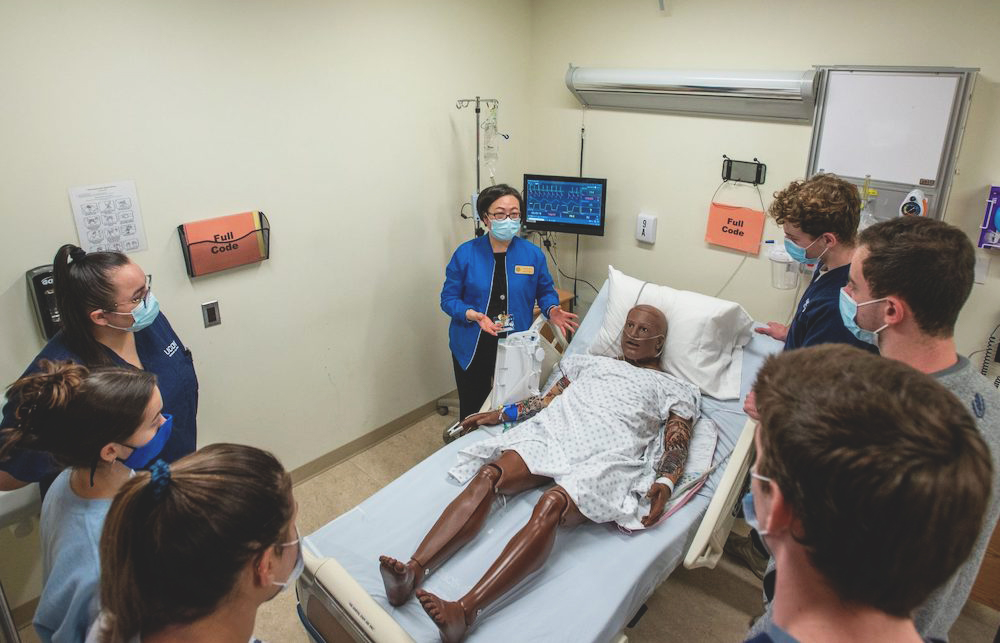UConn Escape Room Simulation Scenarios Enhance Nursing Education
Escape rooms are a valuable tool in clinical simulation, as they present real-world challenges in a safe and risk-free environment. Today, more and more educators are incorporating escape room scenarios into their curriculums to better assess learner skill sets while helping to increase their confidence in providing quality patient care. One such institution utilizing escape room simulation scenarios to educate nursing learners is the University of Connecticut. Through puzzles, riddles, clues and more, UConn learners are able to enhance their vital nursing skills.
In the article, “Padlocks, Riddles, and Medication Safety: An Innovative Teaching Tool for UConn Nurses,” author Jaclyn Severance shares an example of an escape room scenario involving an 84-year-old patient. Upon beginning the scenario, UConn School of Nursing undergraduate learners are told the patient has been diagnosed with a urinary tract infection and admitted for treatment. Yet they must overcome certain obstacles before they can appropriately administer the correct medications.
Medical simulation scenarios such as this one are important, because while medication administration may seem less challenging than healthcare procedures, an error in doing so can be detrimental to patient well-being. In addition to the administration element of medications, knowing how to properly retrieve and log them are equally as important to the treatment process.
Sponsored Content:
In the article, Severance writes: “Simulation is a critical component of nursing education, providing the opportunity for nursing students to train hands-on for work in clinical settings and allowing them to learn from their mistakes without endangering real patients.” She also shares several testimonials from UConn School of Nursing colleagues who emphasize that escape rooms have truly added to the overall learning experience the university is able to provide.
To be able to offer the most authentic escape room experiences, the school has acquired several lifelike manikins that represent the diverse population of patients that nurses may encounter in the field. Being able to simulate bodily functions such as breathing, pulses, talking and more extends an element of realism to each clinical simulation experience.
Further, Severance notes that in the case of the 84-year-old with a urinary tract infection, a manikin was used to represent the physical patient. Severance explains that the simulation “took four hours, with the first hour used as a session to introduce the objectives of the exercise. The second hour involved the actual escape room simulation, and the final two hours were used to debrief with the students following the exercise.”
While all learners were able to “escape” in this particular scenario, varying cases may present different challenges with varying difficulty levels. According to one UConn faculty member interviewed for this article, instructors considering the implementation of escape rooms should “keep it simple and beta test their scenario before using it as part of a class.”
Sponsored Content:
Unlocking Innovation: Using Escape Rooms in Nursing Simulation
This one-hour beginner HealthySimulation.com webinar is designed to introduce learners to unlocking innovation in nursing education through game-based learning in the form of an escape room. Presented by UConn Assistant Professor Carrie Morgan Eaton, PhD, RNC-OB, C-EFM, CHSE, explains how game-based learning (such as an escape room) is an innovative way to make learning fun, interactive and engaging.
This webinar introduces learners and educators to the process of creating an escape room experience. Once they understand the basic steps, tools, and resources, they will be able to build on their own scenario and add complexity. This webinar also demonstrates how five basic ideas drawn from the mastery of a clinical concept can evolve into an escape room.
At the conclusion of the webinar, participants will be provided with a list of all the resources to plan, organize, and implement their own escape room so they can begin unlocking innovation in their approach to nursing education. Learning objectives include being able to determine how to use escape rooms to engage nursing learners, and understanding the steps needed to create an escape room (including the various tools and resources needed). Another objective is for learners and educators to learn how to both design and implement an escape room specifically for nursing education.
More about the presenter: Eaton is an Assistant Professor at the University of Connecticut School of Nursing in Storrs, CT and a Labor and Delivery Nurse at Saint Francis Hospital, Trinity Health of New England in Hartford, CT. Her Bachelor of Science degree in Nursing is from Sacred Heart University in Fairfield, CT, where she also obtained her Master’s degree in Clinical Nurse Leadership. Her Doctor of Philosophy degree in Nursing is from the University of Connecticut where she studied under the guidance of Dr. Cheryl Tatano Beck.
Eaton is an alumna of the National League for Nursing Simulation Leadership Program, and has received national recognition from the Association of Women’s Health, Obstetric, and Neonatal Nurses (Emerging Leader) and the International Association for Clinical Simulation and Learning (Academic Excellence). Eaton has focused her simulation research efforts on training students and providers in neonatal and obstetrics scenarios. Her research interests are focused on maternal mental health.
Read Full UConn Article Here
Photo Credit: Sean Flynn / UConn Photo
Lance Baily, BA, EMT-B, is the Founder & CEO of HealthySimulation.com, which he started while serving as the Director of the Nevada System of Higher Education’s Clinical Simulation Center of Las Vegas back in 2010. Lance is also the Founder and acting Advisor to the Board of SimGHOSTS.org, the world’s only non-profit organization dedicated to supporting professionals operating healthcare simulation technologies. His co-edited Book: “Comprehensive Healthcare Simulation: Operations, Technology, and Innovative Practice” is cited as a key source for professional certification in the industry. Lance’s background also includes serving as a Simulation Technology Specialist for the LA Community College District, EMS fire fighting, Hollywood movie production, rescue diving, and global travel. He and his wife Abigail Baily, PhD live in Las Vegas, Nevada with their two amazing daughters.
Sponsored Content:





















